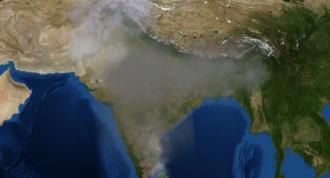
According to the World Health Organization, the safe limit of PM2.5 concentration for humans is 25 micrograms/cubic metre. But, the fact that at any given time, the PM2.5 levels in Delhi hover between 303.9 and 408.2 -- way above the safe level -- is no news! Newspaper headlines scream on toxic pollution levels and people wearing protective masks has become a common sight.
PM2.5 technically refers to tiny atmospheric particulate matter (PM) that have a diameter of up to 2.5 micrometers. They are often released into the air by the noisy engines of our vehicles, or by burning garbage or biomass, or by industries.
Amidst the frightening PM2.5 levels, many hope for that clean air coming their way some day. To convince us that there is action, statistics are dished out on huge amounts of money being sanctioned for pollution control. Alas, we do not even have official data to measure the exact impact of air pollution on the health of people. Are we taking a shot in the dark? Perhaps!
In the absence of data on deaths related to air pollution, the Central Pollution Control Board (CPCB) has decided to commission a study based on data from government hospitals across the country to get an accurate picture of health impact of air pollution. Decision by the CPCB apparently comes in the wake of alarming findings by a collaborative study called the ‘Burden of Disease Attributable to Major Air Pollution Sources in India’, which said that air pollution contributed to more than 10% of deaths in the country. In 2015, premature mortality attributed to air pollution contributed to nearly 1.1 million deaths. Of these, 75% were in the rural areas.
The CPCB was quoted by the media as saying that morbidity and mortality rates due to air pollution are being reported in the media without the knowledge of how these are being calculated. The reports quoted Ministry officials as saying that the government is developing a methodology for Indian conditions.
In 2015, the Government told the Parliament that 35,000 people had died due to acute respiratory infections across India between January 2006 and middle of 2015. The deaths are not directly attributed to air pollution.
The Burden of Disease Attributable to Major Air Pollution Sources in India study provides the first comprehensive analysis of the levels of fine particulate matter air pollution in India by source at the state level and their impact on health. It is the result of the Global Burden of Disease from Major Air Pollution Sources (GDB MAPS) project, an international collaboration of the Indian Institute of Technology Bombay, Health Effects Institute, USA and the Institute for Health Metrics and Evaluation, USA.
The analysis showed that household burning and coal combustion are the single largest sources of air pollution-related health impact, with emissions from agricultural burning, anthropogenic dusts, transport, other diesel, and brick kilns also contributing significantly. Using three different scenarios projecting out to the year 2050, the study identifies in detail the challenges posed by the many sources of air pollution in India, but also highlights the significant progress that can be made.
Also in the year under study (2015), one in four deaths from particulate pollution in India was due to household biomass burning, the study said. Combustion of coal in power plants and industries led to 15% of pollution-related deaths. Together, these sources took 437,000 lives in 2015, mostly in rural India. As many as 1.09 million deaths were attributed to PM2.5 pollution, data show. Even with the most active reductions under an ‘aspirational’ scenario, PM2.5 exposure is projected to cause 2.5 million deaths in 2050.
Amid wrangling as to whether ‘air pollution’ causes deaths, the National Human Rights Commission (NHRC) in January issued notices to all states and union territories on the issue of vehicular pollution affecting the respiratory system and even the reproductive health of traffic police. This move comes in the wake of an application by Dr. Sanjay Kulshreshtha to the NHRC that the traffic police were the worst hit because of vehicular pollution as they performed duties at crossings where pollution levels were maximum.
As response to the NHRC directive is awaited, a newspaper report said that the air teenage girls breath may be causing irregular menstrual cycles and that the negative health effects from air pollution exposure are infertility, metabolic syndrome and polycystic ovarian syndrome. The study, published in the journal Human Reproduction is the first to show that exposure to air pollution among teen girls is associated with slightly increased chances of menstrual irregularity.
If you thought this was an ‘urban’ problem, people living in rural areas have no reason to celebrate when it comes to breathing clean air, either! The production of straw in Punjab and Haryana has been around 28.5 million tonnes, of which 20.1 million tonnes is burnt to clear the agricultural land for Rabi crops. Smoke from this travels and settles over areas around Delhi, adding to the toxicity created by dust and polluting emissions. Exposure to PM2.5 from burning of domestic biomass chulha is the deadliest source of air pollution in India, responsible for around 25% of pollution linked deaths in the country, according to the Burden of Disease Attributable to Major Air Pollution Sources in India study.
The Central Government has decided to earmark Rs.1000 crore in the coming budget to tackle the problem of stubble burning in Delhi’s neighbouring states, in an effort to make the capital’s air more breathable.
If you thought long road trips was a way to escape the city’s busy life, and the pollution, think again. A news report by Research Matters says that the exposure to PM2.5 exceeded the permissible limit even on national highways. Passengers travelling in a non-AC car were the most affected, as compared those traveling by bus and AC cars.
Going by the trend, clean air definitely seems to be a distant dream.






